
97
TAÏP CHÍ KHOA HOÏC VAØ COÂNG NGHEÄ ÑAÏI HOÏC COÂNG NGHEÄ ÑOÀNG NAI
Số: 03-2024
SYNTACTIC STRUCTURAL FEATURES OF DESCRIPTIVE
DISCOURSE DEMONSTRATE TEXTUAL FUNCTIONS IN
MODERN VIETNAMESE ESSAY DATA
Le Thi Thanh Uyen1*, Dinh Lu Giang1
1VNUHCM - University of Social Sciences and Humanities
*Corresponding author: Le Thi Thanh Uyen, lethithanhuyen2010@gmail.com
GENERAL INFORMATION
ABSTRACT
Received date: 20/01/2024
Discourse is the complex, flexible entity in the system of
meaning expression consisting of many levels closely and
dialectically related. The syntactic structure principles help
the user shape discourse components appropriately to suit the
content and purpose of the communication. They include the
rules about sentence structure, the agreement between
sentence elements, and the arrangement of words to create
meaning. Understanding and using correct syntactic
structures helps users fully express ideas accurately and
logically. With its characteristic “open” nature, the
descriptive discourse is a useful “tool” that helps individuals
concretize the reality of the multi-dimensional and multi-
faceted world as it is. Because the research object is
complex, we apply and combine the discourse analysis
methods, semantic analysis methods, and description
methods to help us identify accurately and completely the
syntactic structure features that actualize the text creation
function. The survey results not only clarify the conscious or
unconscious rules in the socio-cultural ideology that governs
the communication process but also clarify the aesthetics of
discourse in the literature. At the same time, it affirms the
scientific value of the Systemic Functional Grammar theory.
Revised date: 27/03/2024
Accepted date: 17/04/2024
KEYWORD
Communication;
Discourse & discourse analysis;
Literary genre;
Syntactic structures;
Textual.
1. INTRODUCTION
The basic function of descriptive
discourse is to create a message. The message
is realized through the syntactic structure of
the discourse. Understanding and using the
correct syntactic structure of discourse helps
users express thoughts accurately and
logically. The syntactic structure is the rule of
arranging and combining words/phrases in a
reasonable way to express a certain meaning.
Systemic Functional Grammar theory is a
theory that studies discourse in communication
activities, bringing a mixed, multi-dimensional
perspective from form to content, making an
important contribution to reflecting many
aspects of social life as well as revealing user
attitudes and opinions. The diversity in

TAÏP CHÍ KHOA HOÏC VAØ COÂNG NGHEÄ ÑAÏI HOÏC COÂNG NGHEÄ ÑOÀNG NAI
98
Số: 03-2024
syntactic structure ensures that the process of
creating and conveying user messages takes
place accurately and smoothly.
Currently, the discourse analysis is
approached by the linguists in many different
directions. Based on the research objectives
and the research methods, we temporarily
generalize discourse research into three trends
with main research contents:
(i) The Linguistic approach: formed based
on Saussure’s linguistics (1973) marked the
important change in language research,
emphasizing the structural characteristics of
the discourse. All the individual actions and
social organizational structures are related to
the discourse, so they can be understood as a
system of closely related elements. Each
element in the system only has meaning when
it is placed within an overall structure.
(ii) The Stylistic approach: Bakhtin (1981)
can be seen as the originator of studying
language as an entity in the complex,
multifaceted and constantly changing real life
of the texts/ discourses in the history.
(iii) The Sociological approach: The
center of this approach is Foucault’s (1981)
concepts of the discourse, which does not pay
attention to the verbal structure within the
discourse, but mainly explores the factors that
govern the formation and operation of the
discourse such as ideology, and power. The
literary text is not the object of study of this
approach but is only one of the data examining
the transformation and replacement of the
intellectual systems and the power relations.
It can be seen that three trends in the
approaching discourse provide a theoretical
and methodological framework for the
discourse research projects. Therefore, these
three approaches have had great influence,
influencing almost all the discourse theory in
the 20th century.
From the SFG theoretical system, we hope
to approach the syntactic structure of
Vietnamese sentences from a new, complete,
and comprehensive perspective in each
situational context, helping to clarify the social
and artistic nature of descriptive discourse,
that materializes through literary texts such as
Leisurely Interlocutory by Hoang Phu Ngoc
Tuong, Scattered in Front of the Lamp by Do
Chu, Sit Idle Gossip, Hanoi doesn’t have snow
by Do Phan, The Back of your neck is cold by
Nguyen Ngoc Tu.
However, in reality, it is not always easy
to distinguish clearly between the genres of
prose because there is always an increasingly
strong interference between the genres.
Therefore, we chose the above research data
source because these are publications that have
been confirmed in terms of genre, and
published by reputable publishers.
2. SCIENTIFIC RESEARCH METHODS
The discourse is an independent structural
unit that realizes the user’s thoughts. The
environment for discourse to operate is the
process of interpersonal communication. So,
any type of discourse always exists in a static
state (in each individual’s potential) and a
dynamic state (in the communication
activities). To perform the functions of
thinking and communication, descriptive
discourse must be organized according to its
principles and operate in a system including
many different levels, having a dialectical
relationship with each other.
Linguistics is the experimental science, all
conclusions come from research practice based
on the analysis of the actual data sources.
Therefore, we use the discourse analysis
method to help determine exactly how to
organize and arrange the internal structural
units. The semantic analysis method helps
clarify how messages are created and
conveyed through the syntactic structure. The
descriptive method helps classify the number
and frequency of occurrence 69of
word/phrase/structure patterns in the context
of use. We will use the results as a basis for

99
TAÏP CHÍ KHOA HOÏC VAØ COÂNG NGHEÄ ÑAÏI HOÏC COÂNG NGHEÄ ÑOÀNG NAI
Số: 03-2024
the conclusion about typical features of the
descriptive discourse that perform the text
creation function.
3. RESEARCH RESULTS AND
DISCUSSION
The syntactic structure of descriptive
discourse is built according to linear
principles, so the message structure is also
organized according to linearity. According to
this principle, the descriptive discourse begins
with the Theme and ends with the Rheme. The
text-creating function of the discourse is
expressed through the Theme - Rheme
structure. In particular, the Theme is the
identified component (corresponding to the old
message) combined with the Rheme
component (corresponding to the new
message) to create a complete topic. The user
organizes the descriptive discourse structure as
a message presentation that must be consistent
with the previous (old) message and the
following (new) message as well as
appropriate to the situational context.
The syntactic structure of discourse is a
semantic structure that considers how the
message is formed.
1. Does the discourse have syntactic
meaning? If any, how does that syntactic
meaning characterize the elements in the
discourse?
2. What is the difference between
syntactic meaning and expressive meaning?
3. What is the process of transmitting -
receiving - interpreting the message?
Therefore, the process of organizing and
selecting the Theme is the core prerequisite for
the descriptive discourse to perform the
function of creating text.
3.1. Systemic Functional Grammar
Since the 70s of the twentieth century, the
method of discourse analysis was formed and
developed on the theoretical foundation of
Systemic Functional Grammar founded by
John Rupert Firth. Halliday is the one who
developed and perfected this theoretical
system based on the philosophical concept that
the discourse is the communication system.
That is why when studying discourse, we must
place discourse in a broad socio-cultural
context to understand how users perceive
events (potential meaning) as well as how to
reflect that perception.
The message structure is the type that
links content in depth and is concretized
through discourse structure. Text structure
formalizes discourse structure. Typically, a
message indicates what the user is talking
about and how. However, Vietnamese is a
language that does not change its form, so the
basic structure of a Vietnamese sentence
corresponds to the structure of a clause
consisting of two components: Theme and
Rhyme - “tool” performs text creation
function. In particular, the Theme is the
component linked to the previous message
(old) and creates the focus for the following
message (new). Therefore, the process of
realizing the message’s meaning is mainly
through the Theme.
Starting from the purpose of
communication, we think that establishing the
message structure as the theme plays an
important role, in deciding the entire content
of the message as well as whether the
communication purpose is effective or not, so
Theme development is considered the
framework of the entire text. So, the process of
arranging the Theme components is a reasoned
choice, not arbitrary. This change in order
certainly has a certain communicative impact
on the receiver.
From a syntactic perspective, the syntactic
relationship at the surface and the semantic
relationship at the deep level are closely
related and bound to each other. From a
communication perspective, due to different
purposes, different methods of semantic
expression should be chosen, because after all,

TAÏP CHÍ KHOA HOÏC VAØ COÂNG NGHEÄ ÑAÏI HOÏC COÂNG NGHEÄ ÑOÀNG NAI
100
Số: 03-2024
a semantic structure can use many forms of
syntactic structure to express.
The process of discourse analysis is the
process of decoding discourse from the way
things refer to the situational context, so it is
necessary to generalize the expression into the
Theme system as a fulcrum for the meaning-
creation process. From there, in our opinion,
syntactic meaning and expressive meaning are
two types of meaning in different aspects, with
distinctions in nature. Syntactic meaning is
general and reflects the syntactic relationship
between words/ phrases, while expressive
meaning is specific and reflects the
relationship between phenomena in reality.
3.2. Discourse and descriptive discourse
Discourse research is not a new issue in
scientific research, but it is difficult to have a
complete and convincing view because the
discourse is an entity that is constantly moving
so the discourse always continuously shifts the
meaning in the communication. Therefore, up
to now, the concept of discourse has not been
fully unified. Harris (1952), was a pioneer in
the field of discourse studies. He shows the
relationship between the textual and the social
context of discourse through the distribution of
elements/functions of discourse in textual.
Another researcher emphasized that discourse
is the event of communication that takes place
between the speaker and the listener
(observer...) in the process of communicating,
in some time, space, or other context. This
communication can be verbal, written, its
components can be speech, nonverbal or
linguistic (Dijk, 1989).
From the research of scientists, we think
that discourse is the term for the event of
purposeful, unified, and coherent
communication, recorded in writing according
to its own rules and mechanisms. Depending
on social status, the discourse creators will
form discourse orders to suit their status, at the
same time there will be many different
discursive strategies to persuade others.
Hence, research discourse will help us
understand many interesting aspects of human
cognition about the world. Additionally, we
found that there are quite a few studies
discussing the nature of the verbal art of
discourse in the literature such as Foucaul;
Todorov; Barthes; Bakhtin; Hamburger; Kate;
Compagnon; Jakobson; etc. According to the
opinion of genre theorists Phi, Han & Su in
Dictionary of Literary Terms (1993: 59): “The
essay is any short composition in the form of
prose whose task is to discuss an issue, explain
a point of view, or persuade the reader to
accept a certain point of view on any topic”.
In our opinion: The essay is artistic prose
consisting of many different sub-genres
composed freely, without following a pattern.
The literary nature of the essay genre is the
discourse about life, with ideas and unique
characteristics, so it is suitable for presenting
the message about the objective and subjective
world in the user’s thoughts.
The syntactic structure of descriptive
discourse has the function of concretizing the
relationship between the form and content of
the message. The Theme is a component that
represents potential experiential meaning that
exists independently outside of discourse.
From a formal aspect, the Theme is often
expressed by the noun/noun phrase or the
pronoun that replaces all syntagms that express
substantive meanings such as nouns. However,
it should be noted that text is the external
formal element of discourse, while discourse is
the internal meaningful element of the text.
Discourse is concretized through the form of
text. Thus, discourse analysis must be through
the textual, and cannot be separated from
specific textuals, but it is also not limited by
any textual.
3.3. Syntactic structural features of
descriptive discourse demonstrate textual
functions in modern Vietnamese essay data
The syntactic structure represents the
relationship between external form and

101
TAÏP CHÍ KHOA HOÏC VAØ COÂNG NGHEÄ ÑAÏI HOÏC COÂNG NGHEÄ ÑOÀNG NAI
Số: 03-2024
internal content. Accordingly, the syntactic
structure of the message consists of two parts
(i) the structure outside the units (Theme part)
and (ii) the internal structure inside the units
(Theory part). Starting from the purpose of the
communication, the Theme plays a role in
determining the message semantics, linking
the message together, creating coherence in
content and connection in form for the text.
The Theme in the thinking is to reflect the
user’s perception of the world. At the formal
level, the Theme is concretized by the
nouns/noun phrases or the pronouns that can
be used to replace all syntagms that express
the meaning of the entity part such as a noun.
3.3.1. Topical Theme
The Theme is the defined component that
helps increase the value of the message
because the Theme contains word/phrase
elements, or syntactic structures in the same
semantic field that create the complete topic.
Each text usually revolves around the topic.
However, the Theme does not always coincide
with the message, each type of Theme has
different roles depending on the user’s
communication purpose. If the Theme is not
chosen properly, the syntactic structure of the
descriptive discourse will lose its cohesion and
coherence
Descriptive discourse is linear, so the
message is organized according to linear
characteristics. In terms of sequence, the
process of perceiving the object occurs first,
then the way to organize the syntactic structure
to inform about the object is formed. We can
see that the Theme structure is both
psychological (what the mind chooses as the
starting point) and textual, meaning which
object to choose as the focus of the message is
closely related to how organization of
syntactic structure in the discourse.
Accordingly, the Topical Theme is the type of
topic that has the function of conveying the
message effectively. There are two types of
Topical Themes:
(i) The Marked Theme: The Theme does
not coincide with the subject.
(ii) The Unmarked Theme: The Theme
has the same subject.
The phenomenon of message focalization
represents the special hidden meaning, to
emphasize the message, create an impression,
and attract the recipient’s attention. The user
often uses words/ phrases to replace or
supplement a certain object to intentionally
create the focus for the message that the user
thinks is most important and wants readers to
pay attention to. Because this is the beginning
stage of building the message and also the
basis for considering how meaning is created
and understood. Surveying the data sources,
the syntactic structure of the discourse realized
through the Theme has the following results:
Table 1. Statistics of descriptive discourse
expressing the function of Topical Theme
Topical Theme
Quantity
Rate
(%)
Unmarked topical theme
2028
72.68
Marked topical theme
762
27.32
Total
2790
100
The survey results showed the opening
factor of descriptive discourse has a very clear
modeling function. The fundamental issue here
is not “What is the end?” but “Where does it
come from?”. Consequently, the author mainly
uses the unmarked topical theme (accounting
for 72.68%) to name the state of affairs,
pointing directly at the mentioned object
(person/thing), clearly showing the purpose of
persuasion and direct impact on the receiver.
However, it should be understood that
“determine” is not “known” (old information)
but must be understood more flexibly (Cao





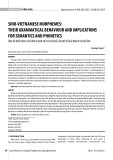


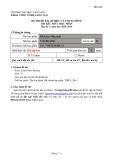
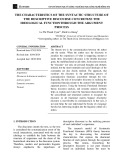

![Bộ câu hỏi trắc nghiệm Văn bản tiếng Việt [chuẩn nhất]](https://cdn.tailieu.vn/images/document/thumbnail/2025/20251127/thuynhung051106@gmail.com/135x160/24021764296609.jpg)


![Bài giảng Ngôn ngữ học đối chiếu Nguyễn Ngọc Chinh [PDF]](https://cdn.tailieu.vn/images/document/thumbnail/2025/20251101/vovu03/135x160/7471762139652.jpg)


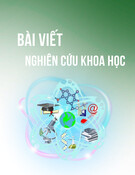


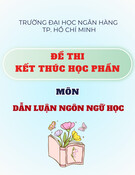

![Ngân hàng câu hỏi môn Tiếng Việt thực hành [chuẩn nhất]](https://cdn.tailieu.vn/images/document/thumbnail/2025/20251003/kimphuong1001/135x160/21861759464951.jpg)
![Bài giảng Văn học phương Tây và Mỹ Latinh [Tập hợp]](https://cdn.tailieu.vn/images/document/thumbnail/2025/20251003/kimphuong1001/135x160/31341759476045.jpg)


